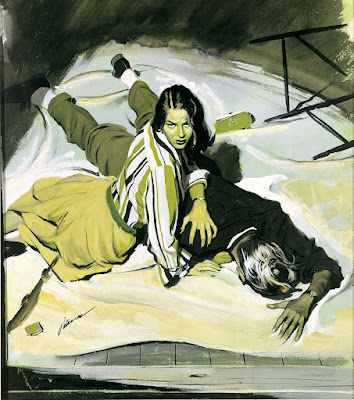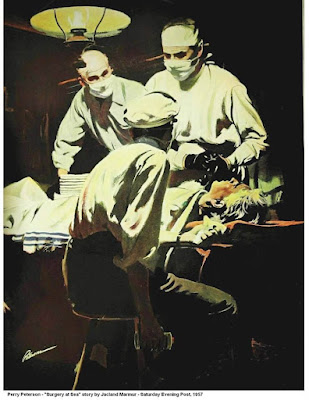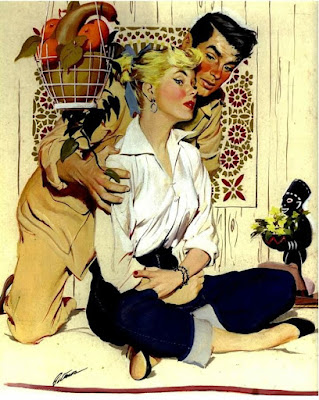Wednesday, May 31, 2023
Two Tugs Dockside
Monday, May 29, 2023
Octopolis
In Australia an unusual society of octopuses has congregated in Jervis Bay, which observers have dubbed "Octopolis."
Octopuses are normally relatively solitary, so this tendency to group together is not fully understood.
Marine biologist Peter Godfrey-Smith reports that he's noticed a lot of "ornery" behavior that resembles fighting, boxing, bullying, and even shooting shell projectiles underwater. He's not completely sure if this is just territorial squabbling or something else.
More at Earth Touch Network.
Sunday, May 28, 2023
Russell Flint on Color Harmony
In his book Water-Colour for Beginners Sir Frances Russell Flint warned that a painting will lack color harmony if it has too many colors in it. He said:
"You must aim at getting tone and harmony in your work, although it may not be easy. All pictures may be divided into masses of bright color or light, medium-strength color, and shadows. It may be difficult to trace the exact places where they occur in a picture, but they are there all the same. It is obvious that when you are working out of doors on a bright sunny day all the colors will be strong and bright in tone, and even the shadows and middle tints will be strong too. The opposite occurs on a dull day, when the whole scene is changed to one of low tone, when both colors and shadows will be soft and subdued. In each case the colors will harmonize and all complement each other in tone. Mix the colors of these two scenes together and the result is a discordant picture which will be unnatural and unbalanced."
Saturday, May 27, 2023
Resources for Art Styles
One positive outcome of the growth of generative AI is an awakened interest in art styles: how to learn about them, recognize them and name them.
Here are some examples of AI-generated images inspired by chainmail art, courtesy Twitter user Anonymouse, who has compiled helpful lists of styles of art and photography to use as inspiration.
Anonymouse has got about five collections so far on various Twitter posts. In his collection #2, for example, he's got ASCII Art, polar panorama, mosaic style, and Fresnel Effect.
Another rich vein of styles is Aesthetics Wiki, which defines and illustrates everything from Barbiecore to Dark Gatsby. This online community seems to be fueled as much by cosplay, anime art, and toys as it does by AI, but apparently the team at Midjourney took a lot of inspiration from these communities when they were developing their tools.
Every art school—and especially every design school—should offer classes that explore these art and photography styles, putting them in context without judgment.
Have you found other resources for learning about art styles? Please share them in the comments.
Thursday, May 25, 2023
Me vs. Chatbot: Ask Us Anything
The idea is to see who answers better: real me, or Jimbot, the AI chatbot, who is trained on all my blog posts, books, and magazine articles. (In the “fake” chatbot version, it’s actually me reading the lines, but everything I say is scripted by my digital double). Send your question for either or both of us at this Speakpipe link.
Wednesday, May 24, 2023
Big Rhodies, Tiny Panel
Tuesday, May 23, 2023
The Tragic Fate of Florence Munnings
"When not in pursuit of the hunt, Munnings was in demand elsewhere, traveling up and down to London and Suffolk after their marriage. Florence, left in Cornwall, was neglected. Her friendship with a young captain in the Monmouthshire Regiment, Gilbert Evans, drew closer in these years – to the point in April 1914 when he realized the potential seriousness of their growing affection and decided that his only recourse was to leave England by joining a Royal Engineers Survey of Nigeria. Amid suspicions that she was pregnant by Gilbert, she took her own life on 24 July 1914. Munnings thereafter left Cornwall, and never mentioned her again."Quote from Christie’s via the Sunnyside blog
Monday, May 22, 2023
Tickets Now on Sale for Lightbox Expo 2023
Tickets are on sale today at Lightbox Expo 2023
Sunday, May 21, 2023
Paul Joanowits
Paul Joanowits, also known as Pavle "Paja" Jovanović, was a Serbian realist painter who lived from 1859 to 1957. He painted more than 1,100 works during his lifetime.
Saturday, May 20, 2023
Francesco Hayez
Friday, May 19, 2023
Dog Art Exhibition in London
There's an exhibition of dog art this summer in London all summer which includes The Old Shepherd's Chief Mourner by Edwin Landseer and Brizo by Rosa Bonheur.
‘Portraits of Dogs: From Gainsborough to Hockney’ will be on display at The Wallace Collection from 29 March to 15 October 2023
Thursday, May 18, 2023
Artists' Reactions to the Eiffel Tower
Many artists and writers in France were not enthusiastic about the Eiffel Tower, which was presented as a marvel of iron construction at the World's Fair in 1889.
Léon Bloy called it: “this truly tragic street lamp”Paul Verlaine: “this belfry skeleton”Guy de Maupassant: “this high and skinny pyramid of iron ladders, this giant ungainly skeleton”Francois Coppée: “this mast of iron gymnasium apparatus, incomplete, confused and deformed”
Joris-Karl Huysmans: “this hideous column with railings”
It was meant to be a temporary structure but it has become a famous symbol of Paris.
A group of influential artists and architects lobbied against it. Ernest Meissonier, the first president of the Société Nationale des Beaux-Arts joined with Charles Garnier, architect of the Paris Opera, and academic painter William-Adolphe Bouguereau to publish a letter that said:
"Will the city of Paris continue to associate itself with the baroque and mercantile fancies of a builder of machines, thereby making itself irreparably ugly and bringing dishonor to itself? Because the Eiffel Tower that even the commercial Americans didn’t want, will without a doubt dishonor Paris."
But the architect Gustave Eiffel stood his ground:
"What are the reasons given by the artists for protesting against the maintenance of the tower? How useless, how monstrous! What a horror! We’ll talk about usefulness later. Let us concern ourselves, for the moment, only with the aesthetic merit, on which the artists are more particularly competent. I would like to know on what they base their judgment. Because, mark it, sir, my tower, nobody saw it and nobody, before it was built, could say what it will be."
More at JSTOR Daily
Tuesday, May 16, 2023
Portrait Society Seminar 2023
The annual Portrait Society Seminar began with the Faceoff event, where 18 artists painted portraits of 6 models in a 3-hour time span. I painted Alexandria using casein.
It was fun to meet people at a book signing and customize each book with sketches.
Photo by Robin DamoreOn Saturday I was part of a discussion about painting from living, speaking models. I shared the panel with Mary Whyte and Michael Shane Neal.
Monday, May 15, 2023
Sargent's Favorite Model
Sunday, May 14, 2023
Sisyphus Animated
Saturday, May 13, 2023
A Face is Easier to Recognize When It's Moving
Over the last few decades, researchers have learned a great deal about how we recognize faces. Using neuro-imaging techniques, scientists have pinpointed the regions and pathways in our visual systems that help us recognize people we know or celebrities we've seen on the screen.
Recently a group of authors in The Frontiers of Psychology made the following observation: "Most of what we know about face processing was investigated using static face images as stimuli. Therefore, an important question arises: to what extent does our understanding of static face processing generalize to face processing in real-life contexts in which faces are mostly moving?"
The scientists classify facial movement in two categories: static movement (head turning or nodding) and elastic movement (speaking, changing expressions).
The paper summarizes findings in other scientific studies, for example:
1. Faces are much easier to recognize when presented in a video. If you play the video backwards, recognition performance drops off drastically.
2. Smiling faces are easier to recognize.
3. Babies begin developing neural strategies for processing movement as early as three or four months old, and the first year of life is crucial for developing these skills.
---
Read the free paper online: On the facilitative effects of face motion on face recognition and its development by Naiqi G. Xiao et al.Thursday, May 11, 2023
Repin's Portrait of Murashko
Mykola Ivanovych Murashko was a Ukrainian painter, devoted art teacher, art critic and art historian who belonged to the Russian movement of Peredvizhniki or Itinerants. He was also the founder and the first director of his own private drawing school in Kyiv which was supported by many well-known artists, notably Ilya Repin, a friend from the Academy.
Wednesday, May 10, 2023
Way back in the theater
When that happens, I try to capture a lot faces made from dots and dashes. Maybe they’re more expressive that way.

I'm on my way to the Portrait Society Seminar.
Tuesday, May 9, 2023
'Conscious and Precise Observation'

Monday, May 8, 2023
Whitcomb's Tips on Idealizing Women
Golden Age illustrator Jon Whitcomb explained what elements he would change to idealize a woman's face, explaining "what makes a pretty girl pretty."
1. Eyes are sometimes moved further apart. This device helps make a face look younger.
2. The eyebrows are raised.
3. The irises of the eyes are enlarged very slightly.
4. Shadows from lighting are edited for simplicity and sometimes left out altogether.
5. Mouths are usually made a little fuller, especially the lower lip.
6. Superfluous lines, like laugh lines and wrinkles, and irregularities of the jaw and nose are ignored.
"The width of the face is narrowed slightly, since in life, your two eyes see a face that is a composite of the image from both. Eyes are roughly three inches apart, so that your left eye sees a little more of the left cheek, your right eye a little more of the right. Your visual impression is that of a thinner face."
---
From the Famous Artists Course, Lesson 13
Sunday, May 7, 2023
New Book on Perry Peterson
Perry Peterson contributed illustrations to the popular magazines during the heyday of the Saturday Evening Post and Cosmopolitan.
Peterson painted in gouache and casein, and for many years he adapted his style to the printing limitations (black + one color) of the early magazines. That made him a resourceful colorist, and when he moved into full color in the 1950s, he brought a lot of interesting ideas to his pictures.
His paintings were executed quickly, with bold shapes, dynamic brushstrokes, and strong shadows. He only approached the finished painting after plenty of planning, making use of reference photos of models and props.
Sometimes he had photos of models taken in a professional studio in New York City, and other times he shot his reference at home with friends and family.
The book starts out with a biography written by illustration historian Dan Zimmer, who began collecting Peterson's originals many years ago.
At the beginning of the biographical section, he includes many of Peterson's sketches, reference photos, and preliminary studies. After page 26, it's all original art and tearsheets.
The Art of Perry Peterson is 224 pages long, 9x12 inches, hardcover.
Saturday, May 6, 2023
Illustrating the Coronation of George V

The artists had to work fast to complete their drawings for the next day’s paper. “Every artist had a little notebook which he took out of the pocket of his frock coat and made dots in, putting down his top hat to do so.” Read more in the previous post: Covering the Coronation
Friday, May 5, 2023
Walpurgis Night
All these occult revelries have captured the imagination of great artists, philosophers, and composers, such as the Goethe and Felix Mendelssohn. Mendelssohn's secular cantata describes the attempts of Druids in the mountains to practice their pagan rituals in the face of new and dominating religious forces.
Thursday, May 4, 2023
Drawing Over a Painting
Monday, May 1, 2023
Cornwell's Backgrounds
Dean Cornwell (American, 1892-1960) painted illustrations with solid, memorable backgrounds, which attracted favorable reviews from journalists of his day.
A writer for the Brooklyn Daily Eagle said: "no carelessly sketched-in backgrounds here, flimsy and unstable, a mere set for the figures, upon which the ordinary illustrator concentrates his efforts because he considers they tell the whole story."
Cornwell would visualize the backgrounds in terms of how he would build them with his own hands, and he recognized the value of knowledge gained through the hands.

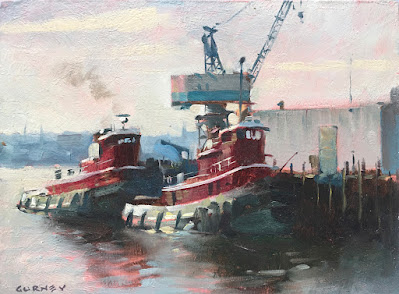




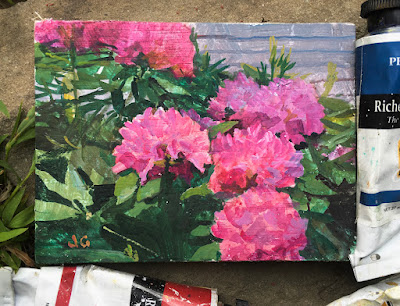



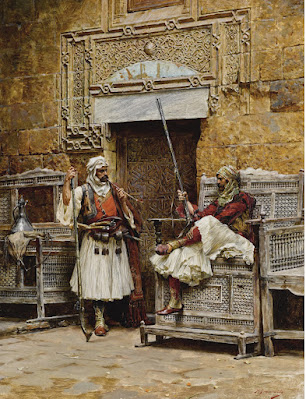

.jpg)



























